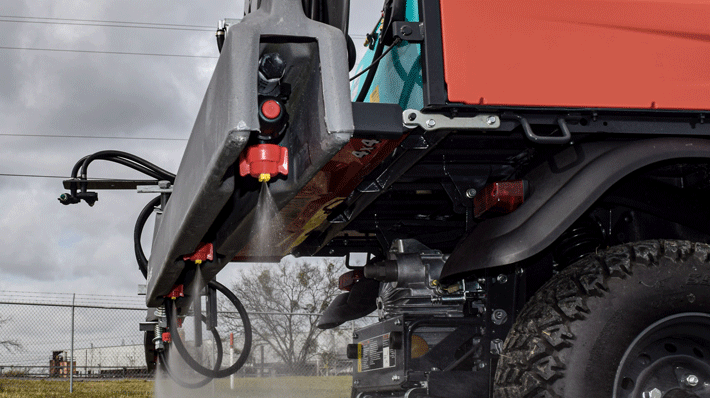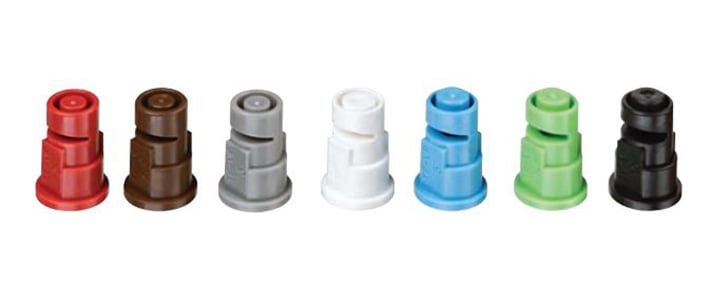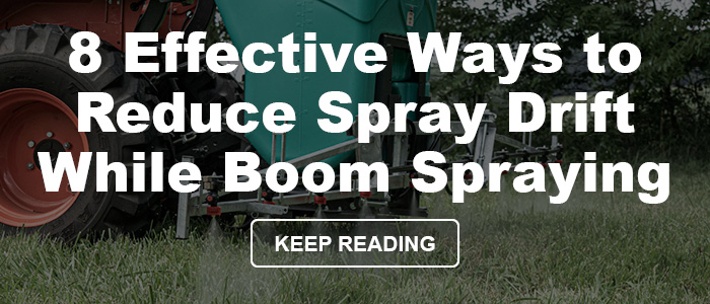
Which nozzles you use on your sprayer is one of the most important factors you need to consider before taking your sprayer to the field. The last thing you want to do is to use the wrong nozzle for the job, and have to go back and spray the field a second time. In this blog, I'll take you through the ins and outs of spray nozzles so you will always know which nozzle is right for the job. There are a lot of different brands out there, but for this blog I will be focusing on TeeJet nozzles.
Why the Right Nozzle Matters
Whether you are spraying crops or weeds, the right nozzle is crucial for effective results. If you use the wrong nozzle, you may apply too little or too much chemical to your crops. A poorly selected or worn-out nozzle will deliver an uneven spray pattern that requires a second application. On the other hand, the right spray tip delivers the ideal amount of chemical where and when you want it.
Droplet Size Is Important
Droplet size varies from very fine to very course. As pressure in your sprayer increases, droplet size decreases. The finest droplets work well for delivering contact chemicals that need to be retained on leaves. Medium sized droplets are most commonly used, and work best for delivering systemic chemicals such as insecticides and fungicides. The coarsest droplets are typically used to deliver residual herbicides or to lessen the chance of spray drift.
Pro tip: While course droplets do reduce spray drift they can bounce and therefore not end up on the weed. Keep this in mind.
Which Type of Spray Nozzle Should You Pick?

Venturi Air Induction Nozzle
The Venturi Air Induction nozzle is also known as an AI nozzle, and features two orifices or openings. The pre-orifice regulates the flow of liquid chemical through the nozzle. The somewhat larger exit orifice determines the spray pattern. An venturi pulls air into the nozzle body where it mixes with water. At a low pressure, the mixture of water and air produces an air-filled spray pattern made up of coarse droplets.
AI nozzles sustain good coverage and are ideal for drift reduction. Most AI nozzles spray in a wide angle flat fan or twin flat fan spray pattern. Some AI nozzles require operation pressure of 30 to 100 PSI for best performance, although some newer nozzles are intended to operate at pressures as low as 15 PSI. Most often, AI nozzles are used for broadcast spraying of:
- Pre-emergence herbicides
- Post-emergence herbicides
- Fungicides
Venturi Air Induction nozzles come in various forms including:
- Venturi Air Induction Nozzle
- Twin Spray Venturi Air Induction Nozzle
- Asymmetric Twin Spray Venturi Air Induction Nozzle
Related: Field Boss® UTV Sprayer
Extended Range Flat Fan Nozzle
The extended range flat fan nozzle is a versatile nozzle that allows you to spray chemical at a variety of pressures. With this nozzle, you can reduce drift by spraying at a lower pressure with a higher flow rate, while spraying at a high pressure will improve leaf coverage.
Using this nozzle at a low pressure with a high flow rate will produce droplets that will be more resistant to drift. Any pressure above 30-40 PSI will produce a fine droplet that is more likely to drift.
Extended range flat fan nozzles are most often used for spraying contact products such as:
- Herbicides
- Insecticides
- Fungicides
Pro tip: Extended range flat fan nozzles should be placed so patterns overlap a minimum of 30%
on each spray pattern edge.

Pre-orifice Flat Fan Nozzle
Pre-orifice flat fan nozzles produce a larger droplet than the standard flat fan nozzle by reducing the internal pressure. The pre-orifice inside the nozzle limits the amount of liquid that enters the nozzle. This produces a drop in pressure through the nozzle tip.
Pre-orifice flat fan nozzles operate best at pressures from 15 - 90 PSI. These nozzles should be mounted with a 30% overlap in each spray pattern. This pre-orifice flat fan version is most commonly used for spraying post-emergence chemicals and is also available in plug-resistant flooding models.
Pre-orifice flat fan nozzles are best for addressing weed issues, including:
- Amazon sprangletop
- Broadleaf signalgrass
- California brome
- Cheatgrass
- Foxtail millet
- Grass weeds
- Itchgrass
- Junglerice
- Quackgrass
- Ripgut brome
- Shattercane
- Southern crabgrass
- Southwestern cupgrass
- Volunteer corn
- Volunteer oat
- Volunteer sorghum
- Wild oat
Related Content: How to Calibrate Your Sprayer

Flooding Nozzles
A flooding nozzle sprays in a flat, wide angle pattern. The pressure of operation affects the width of the spray pattern. The best spray pattern distribution for this nozzle is a 100% overlap. To achieve a 100% overlap, the center of each nozzle should extend to the center of the neighboring nozzles, at the lowest pressure. The minimum overlap in the spray pattern should be no less than 30%. In comparison to the extended flat fan nozzles, drift can be reduced by up to 50%. However, the position that the nozzles are mounted at will affect the spray pattern. It may be necessary to rotate the nozzles 30° to 45° up from horizontal to create a consistent spray between 10 - 30 PSI.
Specialty Nozzles
The venturi air induction nozzle, extended range flat fan nozzle, pre-orifice flat fan nozzle, and flooding nozzle are the most commonly used nozzles. However, specialty nozzles are also available.
Specialty nozzles include:
- Wide Angle
- Extra Wide Angle
- Double-outlet Flat Spray
- Even Flat Spray
- Boomless
- Hollow Cone
- Full Cone
Nozzle Colors
The color of a spray nozzle represents the GPM rate the nozzle outputs at 40 PSI. All nozzles of a certain color, no matter the brand, will spray at a coordinating GPM when operated at 40 PSI. You can check out the full list of nozzles and their spray capacities here.
It is also important to note that you should always use the same nozzles together. In other words, do not mix and match different nozzles, because this will give you a very uneven spray pattern. Depending on the placement of the various nozzles, it may also cause damage to the nozzles, boom or sprayer.
Availability
All TeeJet nozzles are available through dealerships and distributors. Finding your nearest dealer is easy; simply enter your zip code on the TeeJet dealer locator.
I hope you have found this post useful and now have a clearer idea of which nozzle you need for your spraying application. For more helpful info about chemical sprayers and spraying, visit our YouTube channel or subscribe to our blog. To shop a variety of quality sprayers, visit our sprayers page. You also can find your local dealer on our website.


